Thursday 31 August 2006
We take the international train 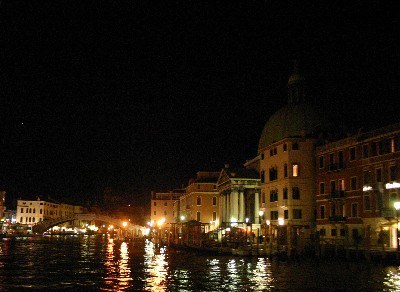 at
5.42p out of Rotterdam to Amsterdam Airport Schiphol. We have already checked in
by internet, so we only have to drop off our luggage. That goes all very quick.
At Schiphol we have something to eat in the food court. Fish in green curry. We
wait for the KLM flight scheduled for 8.40pm. The flight goes off without a
hitch and takes about an hour and twenty minutes. At 10.20pm we are already in
arrivals hall of Marco Polo Airport near Venice. We have to wait a while for our
suitcase to come off the conveyor belt, but it does come in the end. We take the ATVO
bus directly to Piazale Roma. The bus leaves every half hour and costs only
three euros. Tickets are for sale inside the airport terminal. There is also a
city bus run by ACTV, which one hour cheaper. The downside is that it stops
several times on its route to Venice. After a good twenty minutes we arrive at Piazale Roma
in Venice. We have to wait about ten minutes at the ACTV Vaporetto-station for
our waterbus or vaporetto number 1 which takes us over the Canal Grande to Santa
Maria del Giglio. It is a wonderful introduction to Venice, navigating the
channel along the illuminated palaces. Around midnight we are there. It is in
the San Marco district, in middle of town. We have booked a room in a (gay) b&b, Palazzetto
Barbaro del Giglio, run by Gilles Gubelmann and his partner Roman Sadnik. at
5.42p out of Rotterdam to Amsterdam Airport Schiphol. We have already checked in
by internet, so we only have to drop off our luggage. That goes all very quick.
At Schiphol we have something to eat in the food court. Fish in green curry. We
wait for the KLM flight scheduled for 8.40pm. The flight goes off without a
hitch and takes about an hour and twenty minutes. At 10.20pm we are already in
arrivals hall of Marco Polo Airport near Venice. We have to wait a while for our
suitcase to come off the conveyor belt, but it does come in the end. We take the ATVO
bus directly to Piazale Roma. The bus leaves every half hour and costs only
three euros. Tickets are for sale inside the airport terminal. There is also a
city bus run by ACTV, which one hour cheaper. The downside is that it stops
several times on its route to Venice. After a good twenty minutes we arrive at Piazale Roma
in Venice. We have to wait about ten minutes at the ACTV Vaporetto-station for
our waterbus or vaporetto number 1 which takes us over the Canal Grande to Santa
Maria del Giglio. It is a wonderful introduction to Venice, navigating the
channel along the illuminated palaces. Around midnight we are there. It is in
the San Marco district, in middle of town. We have booked a room in a (gay) b&b, Palazzetto
Barbaro del Giglio, run by Gilles Gubelmann and his partner Roman Sadnik.
We are being welcomed
with a glass of Prosecco. We get the Valmont room: a classically
decorated room with a four poster bed. We are tired retire shortly after
finishing our drinks.
Friday 1 September 2006
After a good and deep night's
sleep we awake in our beautiful room. 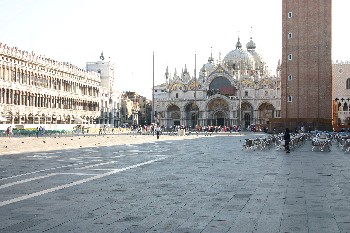 We
get a simple, yet immaculate breakfast which we eat together with our fellow
guests and our hosts. Then we are on our way to the Piazza S. Marco, the tourist
epicentre of the city. The square is often referred to as the Piazza. Venetians
are so satisfied with this square, that it is the only square in town that is
called a piazza (square). All other squares are called Campo, Piazetta or
Piazzale. At 9 am it is fairly quiet still, but that is probably because most
sights are still closed. The San Marco basilica opens at 9.45. That is why we
start with the Campanile, the bell tower on the Piazza. The view is breath
taking. The strange thing is, is that you cannot see any canals from up there,
because the city is so densely settled. We have a cappuccino on a terrace on the
Molo, de waterfront near the Piazza where the gondolas are moored and the view
on the Canal Grande and the Lagoon is great. It does not come cheap at €7.20
per cup, but the view is included. After coffee we go and buy a Venice
card . This card at €54 offers 72 hours unlimited travel with the vaporetti
(water busses) and admission to the municipal
museums and those churches, associated to the CHORUS
organisation. There are cheaper versions of the card, with shorter validity
and/or the museums/churches excluded. Wether we are saving money we do not know,
but it is very handy. A single ride on the vaporetti (within the centre) costs 5
euros, so 4 rides a day will earn our money back. We
get a simple, yet immaculate breakfast which we eat together with our fellow
guests and our hosts. Then we are on our way to the Piazza S. Marco, the tourist
epicentre of the city. The square is often referred to as the Piazza. Venetians
are so satisfied with this square, that it is the only square in town that is
called a piazza (square). All other squares are called Campo, Piazetta or
Piazzale. At 9 am it is fairly quiet still, but that is probably because most
sights are still closed. The San Marco basilica opens at 9.45. That is why we
start with the Campanile, the bell tower on the Piazza. The view is breath
taking. The strange thing is, is that you cannot see any canals from up there,
because the city is so densely settled. We have a cappuccino on a terrace on the
Molo, de waterfront near the Piazza where the gondolas are moored and the view
on the Canal Grande and the Lagoon is great. It does not come cheap at €7.20
per cup, but the view is included. After coffee we go and buy a Venice
card . This card at €54 offers 72 hours unlimited travel with the vaporetti
(water busses) and admission to the municipal
museums and those churches, associated to the CHORUS
organisation. There are cheaper versions of the card, with shorter validity
and/or the museums/churches excluded. Wether we are saving money we do not know,
but it is very handy. A single ride on the vaporetti (within the centre) costs 5
euros, so 4 rides a day will earn our money back. 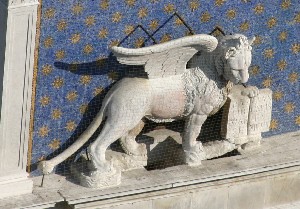 We buy the cards at the Tourist Information office on the Zecca quay near the
piazza. After that we go to the San Marco basilica. The crowds are not
that bad. Rucksacks have to be left at a depository nearby in the Calle San
Basso (without charge). The interior of the church is impressive. Entry is free,
but the interesting parts like the treasury, the altar screen cost a total of 5
euros. Venice card is not valid. Practically everywhere in the city you see the
figure of a winged lion with a book that reads "Pax tibi, Marce evangelista
meus. Hic requescet corpus tuum"
(Peace be with you Marcus, my evangelist. Here will thou body rest). It refers
to the legend that tells us that an angels appears to the evangelist saying
those words when he was, on his way back to Rome, and seeking shelter at the
lagoon. This story was meant to give the first Venetians the feeling that they
were at the basis of Christianity. In 828 Venetians went to Alexandria and stole
the body of St Marc from his grave and brought him over to Venice. The basilica
was built as a shrine for this special relic. Meanwhile the present church is
the third one on this site. Constructions started in 1063. Byzantine influences
are visible in the cupolas. The facades are carefully decorated. Inside we see a
lot of fine mosaics. In the Treasury we see many icons, relics and other
treasures. The biggest treasure of all is behind the altar. It is the Pala d'Oro,
the golden altar screen. To see it you have to fork out another 2 euros. The
screen dates back to 976, comes from Constantinopel and was later enlarged and
decorated. It contains countless details gold, enamel, Safire, ruby and lots
more. The detail of the representations is so fine, that it takes 40/20 vision
to see it all. On top of that you need a lot of knowledge on medieval
icons.
We buy the cards at the Tourist Information office on the Zecca quay near the
piazza. After that we go to the San Marco basilica. The crowds are not
that bad. Rucksacks have to be left at a depository nearby in the Calle San
Basso (without charge). The interior of the church is impressive. Entry is free,
but the interesting parts like the treasury, the altar screen cost a total of 5
euros. Venice card is not valid. Practically everywhere in the city you see the
figure of a winged lion with a book that reads "Pax tibi, Marce evangelista
meus. Hic requescet corpus tuum"
(Peace be with you Marcus, my evangelist. Here will thou body rest). It refers
to the legend that tells us that an angels appears to the evangelist saying
those words when he was, on his way back to Rome, and seeking shelter at the
lagoon. This story was meant to give the first Venetians the feeling that they
were at the basis of Christianity. In 828 Venetians went to Alexandria and stole
the body of St Marc from his grave and brought him over to Venice. The basilica
was built as a shrine for this special relic. Meanwhile the present church is
the third one on this site. Constructions started in 1063. Byzantine influences
are visible in the cupolas. The facades are carefully decorated. Inside we see a
lot of fine mosaics. In the Treasury we see many icons, relics and other
treasures. The biggest treasure of all is behind the altar. It is the Pala d'Oro,
the golden altar screen. To see it you have to fork out another 2 euros. The
screen dates back to 976, comes from Constantinopel and was later enlarged and
decorated. It contains countless details gold, enamel, Safire, ruby and lots
more. The detail of the representations is so fine, that it takes 40/20 vision
to see it all. On top of that you need a lot of knowledge on medieval
icons.
After the visit to the San Marco
basilica we move on to the Doge Palace (Venice
Card valid!) next door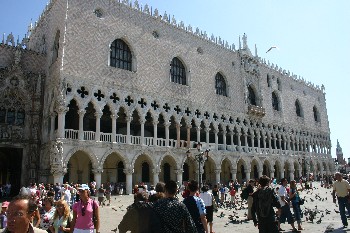 .
Here too, we have to leave our rucksacks behind. Photography is prohibited. We
enter in a courtyard opposite the Scala dei Giganti (staircase of the giants).
On these steps the new Doge was inaugurated. Through the Scala d'Oro (Golden
stairs) we get to the first floor. The tour takes us through numerous impressive
rooms. Many of the rooms were meant to impress the visitors. Inside the Doge
Palace the government of the Venetian republic resided from the early middle
ages until 1792 when Venice was conquered by Napoleon. The Doge was head of
government and was elected throug an intricate system. Many of the rooms served
as meeting halls for the various layers of government, councils and courts.
Others were the state and personal quarters of the Doges. Behind the palace are
the new prisons. They are connected to the palace by the Bridge of Sighs from
1600. The name refers to the sighs of the prisoners on their way to
incarceration. In fact these inmates got off lightly. Many of the convicted were
eventually hanged on the piazza. . .
Here too, we have to leave our rucksacks behind. Photography is prohibited. We
enter in a courtyard opposite the Scala dei Giganti (staircase of the giants).
On these steps the new Doge was inaugurated. Through the Scala d'Oro (Golden
stairs) we get to the first floor. The tour takes us through numerous impressive
rooms. Many of the rooms were meant to impress the visitors. Inside the Doge
Palace the government of the Venetian republic resided from the early middle
ages until 1792 when Venice was conquered by Napoleon. The Doge was head of
government and was elected throug an intricate system. Many of the rooms served
as meeting halls for the various layers of government, councils and courts.
Others were the state and personal quarters of the Doges. Behind the palace are
the new prisons. They are connected to the palace by the Bridge of Sighs from
1600. The name refers to the sighs of the prisoners on their way to
incarceration. In fact these inmates got off lightly. Many of the convicted were
eventually hanged on the piazza. .
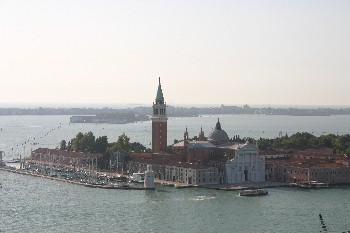 We
have lunch at Osteria da Carla near the Piazza. It is reasonably prices to
Venetian standards. In the afternoon we take a bus boat to San
Giorgio Maggiore. This is an island opposite the Doge Palace in the lagoon.
On the island there is a church and a monastery with the same name. There is
also a Campanile that offers magnificent views on the lagoon, the city and the
Piazza San Marco. We
have lunch at Osteria da Carla near the Piazza. It is reasonably prices to
Venetian standards. In the afternoon we take a bus boat to San
Giorgio Maggiore. This is an island opposite the Doge Palace in the lagoon.
On the island there is a church and a monastery with the same name. There is
also a Campanile that offers magnificent views on the lagoon, the city and the
Piazza San Marco.
We sail back with the vaporetto
(#82) to the Riva degli Schiavoni, the quay East of the Doge Palace. From here
we start a walk through the Castello district in the direction of the Rialto
bridge. This is where we get - in as far that is possible - a bit off the beaten
track. The district is relatively quiet with fewer tourists. We start at the San Zaccaria
church, which is covered in scaffolding unfortunately. The church has a shrine
for the body of  Zacharias, the father of St John the Baptist. Via the Ruga Giuffa we reach the Santa Maria Formosa
church (Venice
Card!). It is on a spacious square, where sit down for a drink. The square is at
the crossroads of a couple of major routes on the East side of town. There are
some vegetable and fruit stalls. We continue to the Santi
Giovanni e Paolo church on the square by the same name. An impressive square
with a big red brick church, a equestrian statue and the Scuola Grande de San
Marco. The latter used to be a congregation, but since its dissolution the
building serves as the entrance building for a hospital. The Giovanni en Paolo
church is dubbed Zanipolo in Venetian dialect and is a large place of worship
for the Dominican order. We lack the energy to pay it a thorough visit and
continue towards the tiny Santa Maria dei Miracoli church (Venice Card!).
The late 15th century church was built around a Madonna picture from 1409. It
started to work miracles around 1480. A lot of marble has got into building the
church and much effort has gone into making it an impressive church despite its
small size. There a lots of statues with amazing detail. Not much later we pass
the post office and the Rialto bridge. In a narrow alleyway near the Campo San Bartolomeo,
in the Calle della Bissa we find the tiny bar Alla
Botte. Here we eat some Cicheti , a kind of tapas, and drink a
prosecco, the Italian sparkling wine, which is open almost everywhere and sold
by the glass.
Zacharias, the father of St John the Baptist. Via the Ruga Giuffa we reach the Santa Maria Formosa
church (Venice
Card!). It is on a spacious square, where sit down for a drink. The square is at
the crossroads of a couple of major routes on the East side of town. There are
some vegetable and fruit stalls. We continue to the Santi
Giovanni e Paolo church on the square by the same name. An impressive square
with a big red brick church, a equestrian statue and the Scuola Grande de San
Marco. The latter used to be a congregation, but since its dissolution the
building serves as the entrance building for a hospital. The Giovanni en Paolo
church is dubbed Zanipolo in Venetian dialect and is a large place of worship
for the Dominican order. We lack the energy to pay it a thorough visit and
continue towards the tiny Santa Maria dei Miracoli church (Venice Card!).
The late 15th century church was built around a Madonna picture from 1409. It
started to work miracles around 1480. A lot of marble has got into building the
church and much effort has gone into making it an impressive church despite its
small size. There a lots of statues with amazing detail. Not much later we pass
the post office and the Rialto bridge. In a narrow alleyway near the Campo San Bartolomeo,
in the Calle della Bissa we find the tiny bar Alla
Botte. Here we eat some Cicheti , a kind of tapas, and drink a
prosecco, the Italian sparkling wine, which is open almost everywhere and sold
by the glass.
At night we eat at da Rafaele, not far from our B&B. It is romantically situated directly on the
canalside, where gondolas are passing by. It does not get much more Venetian
than this. The food is reasonably good, yet Venetian expensive: €170. Later at
night we have a cocktail in a piano bar near the B&B.
Weather: sun, 25 degrees.
|